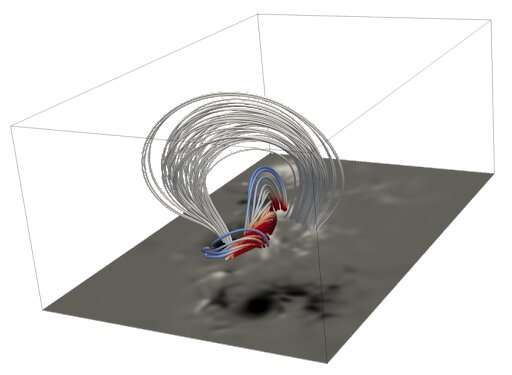TL;DR:
- Scientists at the University of Graz and Skoltech have employed AI to simulate the sun’s magnetic field in real-time, revolutionizing solar physics.
- By integrating observational data with a physical force-free magnetic field model, the team gained a comprehensive understanding of the sun’s behavior and its impact on space weather.
- Real-time simulations of solar activity enable enhanced analysis and forecasting of space weather events.
- The research showcased the temporal evolution of free magnetic energy within the sun’s coronal volume, providing valuable insights into solar eruptions.
- The use of AI techniques and physics-informed neural networks offers transformative potential for advancing simulation capabilities.
Main AI News:
In a groundbreaking collaboration between the University of Graz and Skoltech, scientists have accomplished a major breakthrough in solar physics through the ingenious utilization of artificial intelligence (AI). Their pioneering research, published in Nature Astronomy, showcases the remarkable potential of AI in simulating the magnetic field of the sun’s upper atmosphere in quasi real-time. This achievement holds tremendous promise for advancing our comprehension of the sun’s behavior and its profound impact on space weather, with far-reaching implications for critical infrastructures such as electricity, aviation, and space-based technology.
At the heart of space weather lies the solar magnetic field, acting as the principal catalyst for disruptive phenomena. Severe space weather events, capable of inflicting damage on our infrastructure, originate from solar active regions—areas surrounding sunspots where potent magnetic fields surge through the sun’s surface. Currently, our observational capabilities are limited to measuring the magnetic field solely at the sun’s surface. However, the accumulation and release of energy occur higher up in the solar atmosphere, specifically within the sun’s corona.
Harnessing the capabilities of physics-informed neural networks, the team of researchers has successfully integrated observational data with a physical force-free magnetic field model. This groundbreaking integration has facilitated a comprehensive understanding of the intricate connection between observed phenomena and the underlying physics governing the sun’s activity. Marking a significant milestone in solar physics, this cutting-edge methodology now opens up new frontiers for numerical simulations of the sun.
During their study, the researchers simulated the evolution of an observed solar active region and astoundingly demonstrated the ability to perform force-free magnetic field simulations in real-time. Even more impressive is the fact that this process required less than 12 hours of computation time to simulate a series of observations spanning five days. This unprecedented speed empowers scientists to engage in real-time analysis and forecasting of solar activity, thereby enhancing our capacity to predict space weather events.
Expanding their investigation, the team delved into the temporal evolution of free magnetic energy within the coronal volume—an aspect directly linked to solar eruptive events, such as coronal mass ejections. These events involve the ejection of vast plasma clouds from the sun’s atmosphere, hurtling at speeds ranging from 100 to 3,500 km/s. Confirming the robustness and accuracy of the methodology, a comparison with extreme ultraviolet observations revealed significant depletions of free magnetic energy, both spatially and temporally, in direct correlation with observed solar eruptions.
Robert Jarolim, the lead researcher, emphasized the transformative leap forward made possible by the incorporation of artificial intelligence in their work. By leveraging AI techniques in numerical simulations, the researchers seamlessly integrate observational data, presenting unprecedented opportunities to advance simulation capabilities and broaden our understanding of the sun’s intricacies.
Associate Professor Tatiana Podlachikova from Skoltech underscored the immense promise held by the computational speed achieved in this study. This remarkable feat offers the potential to revolutionize space weather forecasting and deepen our knowledge of the sun’s dynamic behavior.
Conclusion:
The successful utilization of AI in simulating the solar magnetic field represents a significant milestone in solar physics. This breakthrough opens up new opportunities for real-time analysis and forecasting of space weather events, providing invaluable insights for industries reliant on space-based technology, aviation, and electricity. The integration of AI techniques with physics-informed neural networks has the potential to revolutionize the market for space weather forecasting, enhancing our ability to mitigate the potential risks and impacts of solar activity on critical infrastructures.

